Servant Leadership Management Approach: Pros and Cons
VerifiedAdded on 2023/05/29
|7
|2137
|494
AI Summary
This essay defines the servant leadership management approach and discusses its pros and cons. It explains how this leadership style builds strong bonds with employees, embraces diversity, and creates a positive working environment. The essay also provides recommendations for leaders to implement this approach effectively.
Contribute Materials
Your contribution can guide someone’s learning journey. Share your
documents today.
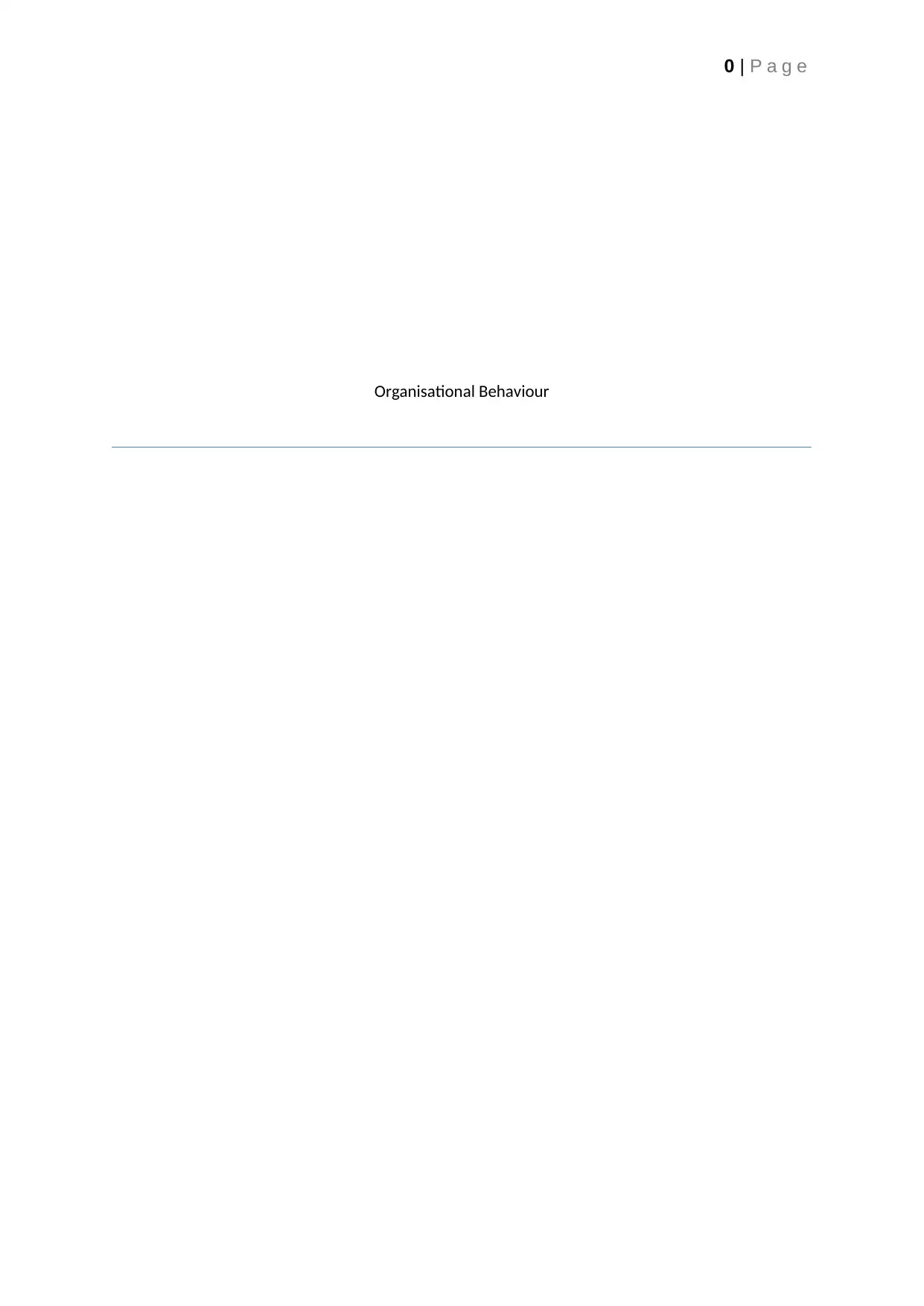
0 | P a g e
Organisational Behaviour
Organisational Behaviour
Secure Best Marks with AI Grader
Need help grading? Try our AI Grader for instant feedback on your assignments.
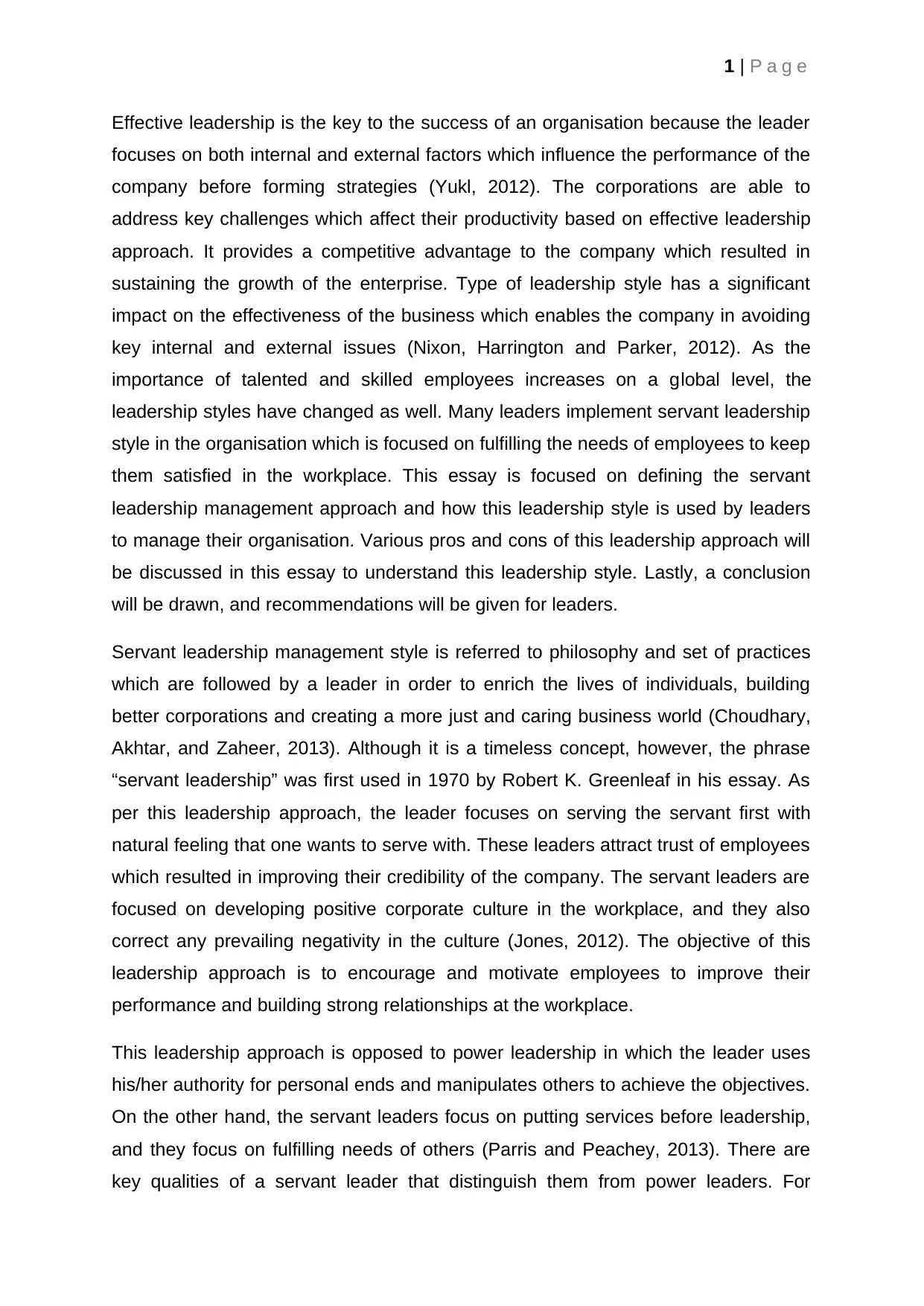
1 | P a g e
Effective leadership is the key to the success of an organisation because the leader
focuses on both internal and external factors which influence the performance of the
company before forming strategies (Yukl, 2012). The corporations are able to
address key challenges which affect their productivity based on effective leadership
approach. It provides a competitive advantage to the company which resulted in
sustaining the growth of the enterprise. Type of leadership style has a significant
impact on the effectiveness of the business which enables the company in avoiding
key internal and external issues (Nixon, Harrington and Parker, 2012). As the
importance of talented and skilled employees increases on a global level, the
leadership styles have changed as well. Many leaders implement servant leadership
style in the organisation which is focused on fulfilling the needs of employees to keep
them satisfied in the workplace. This essay is focused on defining the servant
leadership management approach and how this leadership style is used by leaders
to manage their organisation. Various pros and cons of this leadership approach will
be discussed in this essay to understand this leadership style. Lastly, a conclusion
will be drawn, and recommendations will be given for leaders.
Servant leadership management style is referred to philosophy and set of practices
which are followed by a leader in order to enrich the lives of individuals, building
better corporations and creating a more just and caring business world (Choudhary,
Akhtar, and Zaheer, 2013). Although it is a timeless concept, however, the phrase
“servant leadership” was first used in 1970 by Robert K. Greenleaf in his essay. As
per this leadership approach, the leader focuses on serving the servant first with
natural feeling that one wants to serve with. These leaders attract trust of employees
which resulted in improving their credibility of the company. The servant leaders are
focused on developing positive corporate culture in the workplace, and they also
correct any prevailing negativity in the culture (Jones, 2012). The objective of this
leadership approach is to encourage and motivate employees to improve their
performance and building strong relationships at the workplace.
This leadership approach is opposed to power leadership in which the leader uses
his/her authority for personal ends and manipulates others to achieve the objectives.
On the other hand, the servant leaders focus on putting services before leadership,
and they focus on fulfilling needs of others (Parris and Peachey, 2013). There are
key qualities of a servant leader that distinguish them from power leaders. For
Effective leadership is the key to the success of an organisation because the leader
focuses on both internal and external factors which influence the performance of the
company before forming strategies (Yukl, 2012). The corporations are able to
address key challenges which affect their productivity based on effective leadership
approach. It provides a competitive advantage to the company which resulted in
sustaining the growth of the enterprise. Type of leadership style has a significant
impact on the effectiveness of the business which enables the company in avoiding
key internal and external issues (Nixon, Harrington and Parker, 2012). As the
importance of talented and skilled employees increases on a global level, the
leadership styles have changed as well. Many leaders implement servant leadership
style in the organisation which is focused on fulfilling the needs of employees to keep
them satisfied in the workplace. This essay is focused on defining the servant
leadership management approach and how this leadership style is used by leaders
to manage their organisation. Various pros and cons of this leadership approach will
be discussed in this essay to understand this leadership style. Lastly, a conclusion
will be drawn, and recommendations will be given for leaders.
Servant leadership management style is referred to philosophy and set of practices
which are followed by a leader in order to enrich the lives of individuals, building
better corporations and creating a more just and caring business world (Choudhary,
Akhtar, and Zaheer, 2013). Although it is a timeless concept, however, the phrase
“servant leadership” was first used in 1970 by Robert K. Greenleaf in his essay. As
per this leadership approach, the leader focuses on serving the servant first with
natural feeling that one wants to serve with. These leaders attract trust of employees
which resulted in improving their credibility of the company. The servant leaders are
focused on developing positive corporate culture in the workplace, and they also
correct any prevailing negativity in the culture (Jones, 2012). The objective of this
leadership approach is to encourage and motivate employees to improve their
performance and building strong relationships at the workplace.
This leadership approach is opposed to power leadership in which the leader uses
his/her authority for personal ends and manipulates others to achieve the objectives.
On the other hand, the servant leaders focus on putting services before leadership,
and they focus on fulfilling needs of others (Parris and Peachey, 2013). There are
key qualities of a servant leader that distinguish them from power leaders. For
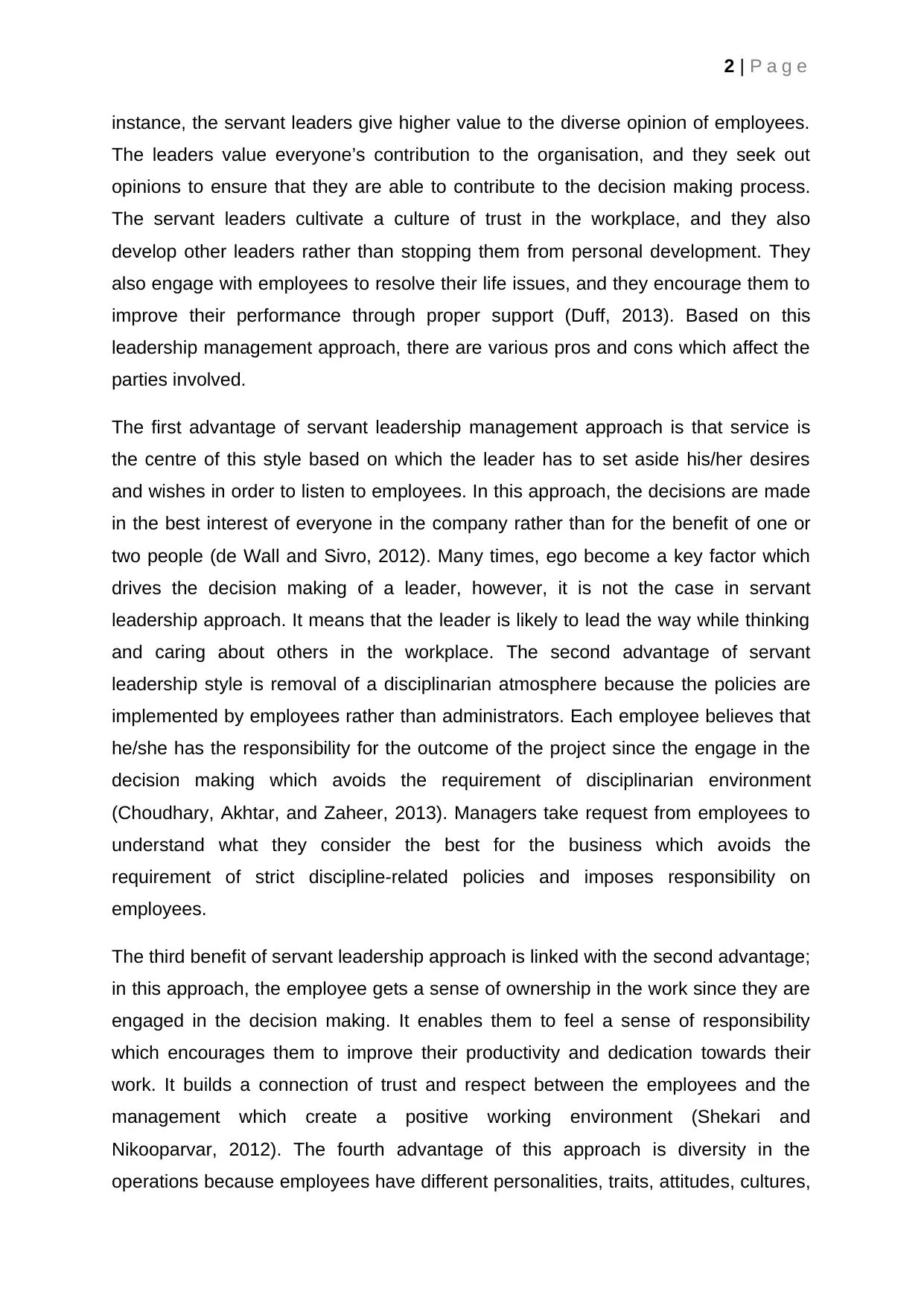
2 | P a g e
instance, the servant leaders give higher value to the diverse opinion of employees.
The leaders value everyone’s contribution to the organisation, and they seek out
opinions to ensure that they are able to contribute to the decision making process.
The servant leaders cultivate a culture of trust in the workplace, and they also
develop other leaders rather than stopping them from personal development. They
also engage with employees to resolve their life issues, and they encourage them to
improve their performance through proper support (Duff, 2013). Based on this
leadership management approach, there are various pros and cons which affect the
parties involved.
The first advantage of servant leadership management approach is that service is
the centre of this style based on which the leader has to set aside his/her desires
and wishes in order to listen to employees. In this approach, the decisions are made
in the best interest of everyone in the company rather than for the benefit of one or
two people (de Wall and Sivro, 2012). Many times, ego become a key factor which
drives the decision making of a leader, however, it is not the case in servant
leadership approach. It means that the leader is likely to lead the way while thinking
and caring about others in the workplace. The second advantage of servant
leadership style is removal of a disciplinarian atmosphere because the policies are
implemented by employees rather than administrators. Each employee believes that
he/she has the responsibility for the outcome of the project since the engage in the
decision making which avoids the requirement of disciplinarian environment
(Choudhary, Akhtar, and Zaheer, 2013). Managers take request from employees to
understand what they consider the best for the business which avoids the
requirement of strict discipline-related policies and imposes responsibility on
employees.
The third benefit of servant leadership approach is linked with the second advantage;
in this approach, the employee gets a sense of ownership in the work since they are
engaged in the decision making. It enables them to feel a sense of responsibility
which encourages them to improve their productivity and dedication towards their
work. It builds a connection of trust and respect between the employees and the
management which create a positive working environment (Shekari and
Nikooparvar, 2012). The fourth advantage of this approach is diversity in the
operations because employees have different personalities, traits, attitudes, cultures,
instance, the servant leaders give higher value to the diverse opinion of employees.
The leaders value everyone’s contribution to the organisation, and they seek out
opinions to ensure that they are able to contribute to the decision making process.
The servant leaders cultivate a culture of trust in the workplace, and they also
develop other leaders rather than stopping them from personal development. They
also engage with employees to resolve their life issues, and they encourage them to
improve their performance through proper support (Duff, 2013). Based on this
leadership management approach, there are various pros and cons which affect the
parties involved.
The first advantage of servant leadership management approach is that service is
the centre of this style based on which the leader has to set aside his/her desires
and wishes in order to listen to employees. In this approach, the decisions are made
in the best interest of everyone in the company rather than for the benefit of one or
two people (de Wall and Sivro, 2012). Many times, ego become a key factor which
drives the decision making of a leader, however, it is not the case in servant
leadership approach. It means that the leader is likely to lead the way while thinking
and caring about others in the workplace. The second advantage of servant
leadership style is removal of a disciplinarian atmosphere because the policies are
implemented by employees rather than administrators. Each employee believes that
he/she has the responsibility for the outcome of the project since the engage in the
decision making which avoids the requirement of disciplinarian environment
(Choudhary, Akhtar, and Zaheer, 2013). Managers take request from employees to
understand what they consider the best for the business which avoids the
requirement of strict discipline-related policies and imposes responsibility on
employees.
The third benefit of servant leadership approach is linked with the second advantage;
in this approach, the employee gets a sense of ownership in the work since they are
engaged in the decision making. It enables them to feel a sense of responsibility
which encourages them to improve their productivity and dedication towards their
work. It builds a connection of trust and respect between the employees and the
management which create a positive working environment (Shekari and
Nikooparvar, 2012). The fourth advantage of this approach is diversity in the
operations because employees have different personalities, traits, attitudes, cultures,
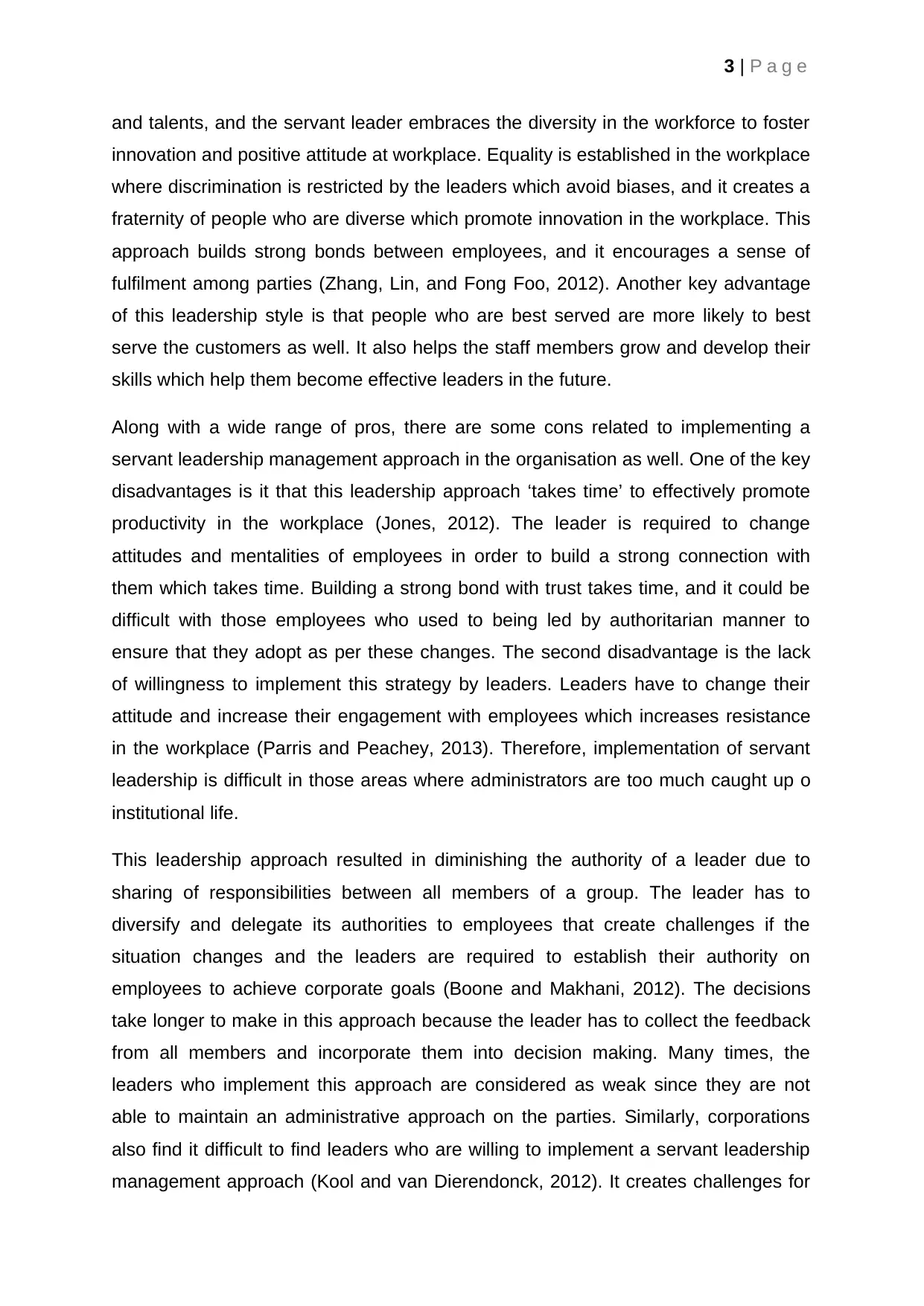
3 | P a g e
and talents, and the servant leader embraces the diversity in the workforce to foster
innovation and positive attitude at workplace. Equality is established in the workplace
where discrimination is restricted by the leaders which avoid biases, and it creates a
fraternity of people who are diverse which promote innovation in the workplace. This
approach builds strong bonds between employees, and it encourages a sense of
fulfilment among parties (Zhang, Lin, and Fong Foo, 2012). Another key advantage
of this leadership style is that people who are best served are more likely to best
serve the customers as well. It also helps the staff members grow and develop their
skills which help them become effective leaders in the future.
Along with a wide range of pros, there are some cons related to implementing a
servant leadership management approach in the organisation as well. One of the key
disadvantages is it that this leadership approach ‘takes time’ to effectively promote
productivity in the workplace (Jones, 2012). The leader is required to change
attitudes and mentalities of employees in order to build a strong connection with
them which takes time. Building a strong bond with trust takes time, and it could be
difficult with those employees who used to being led by authoritarian manner to
ensure that they adopt as per these changes. The second disadvantage is the lack
of willingness to implement this strategy by leaders. Leaders have to change their
attitude and increase their engagement with employees which increases resistance
in the workplace (Parris and Peachey, 2013). Therefore, implementation of servant
leadership is difficult in those areas where administrators are too much caught up o
institutional life.
This leadership approach resulted in diminishing the authority of a leader due to
sharing of responsibilities between all members of a group. The leader has to
diversify and delegate its authorities to employees that create challenges if the
situation changes and the leaders are required to establish their authority on
employees to achieve corporate goals (Boone and Makhani, 2012). The decisions
take longer to make in this approach because the leader has to collect the feedback
from all members and incorporate them into decision making. Many times, the
leaders who implement this approach are considered as weak since they are not
able to maintain an administrative approach on the parties. Similarly, corporations
also find it difficult to find leaders who are willing to implement a servant leadership
management approach (Kool and van Dierendonck, 2012). It creates challenges for
and talents, and the servant leader embraces the diversity in the workforce to foster
innovation and positive attitude at workplace. Equality is established in the workplace
where discrimination is restricted by the leaders which avoid biases, and it creates a
fraternity of people who are diverse which promote innovation in the workplace. This
approach builds strong bonds between employees, and it encourages a sense of
fulfilment among parties (Zhang, Lin, and Fong Foo, 2012). Another key advantage
of this leadership style is that people who are best served are more likely to best
serve the customers as well. It also helps the staff members grow and develop their
skills which help them become effective leaders in the future.
Along with a wide range of pros, there are some cons related to implementing a
servant leadership management approach in the organisation as well. One of the key
disadvantages is it that this leadership approach ‘takes time’ to effectively promote
productivity in the workplace (Jones, 2012). The leader is required to change
attitudes and mentalities of employees in order to build a strong connection with
them which takes time. Building a strong bond with trust takes time, and it could be
difficult with those employees who used to being led by authoritarian manner to
ensure that they adopt as per these changes. The second disadvantage is the lack
of willingness to implement this strategy by leaders. Leaders have to change their
attitude and increase their engagement with employees which increases resistance
in the workplace (Parris and Peachey, 2013). Therefore, implementation of servant
leadership is difficult in those areas where administrators are too much caught up o
institutional life.
This leadership approach resulted in diminishing the authority of a leader due to
sharing of responsibilities between all members of a group. The leader has to
diversify and delegate its authorities to employees that create challenges if the
situation changes and the leaders are required to establish their authority on
employees to achieve corporate goals (Boone and Makhani, 2012). The decisions
take longer to make in this approach because the leader has to collect the feedback
from all members and incorporate them into decision making. Many times, the
leaders who implement this approach are considered as weak since they are not
able to maintain an administrative approach on the parties. Similarly, corporations
also find it difficult to find leaders who are willing to implement a servant leadership
management approach (Kool and van Dierendonck, 2012). It creates challenges for
Secure Best Marks with AI Grader
Need help grading? Try our AI Grader for instant feedback on your assignments.
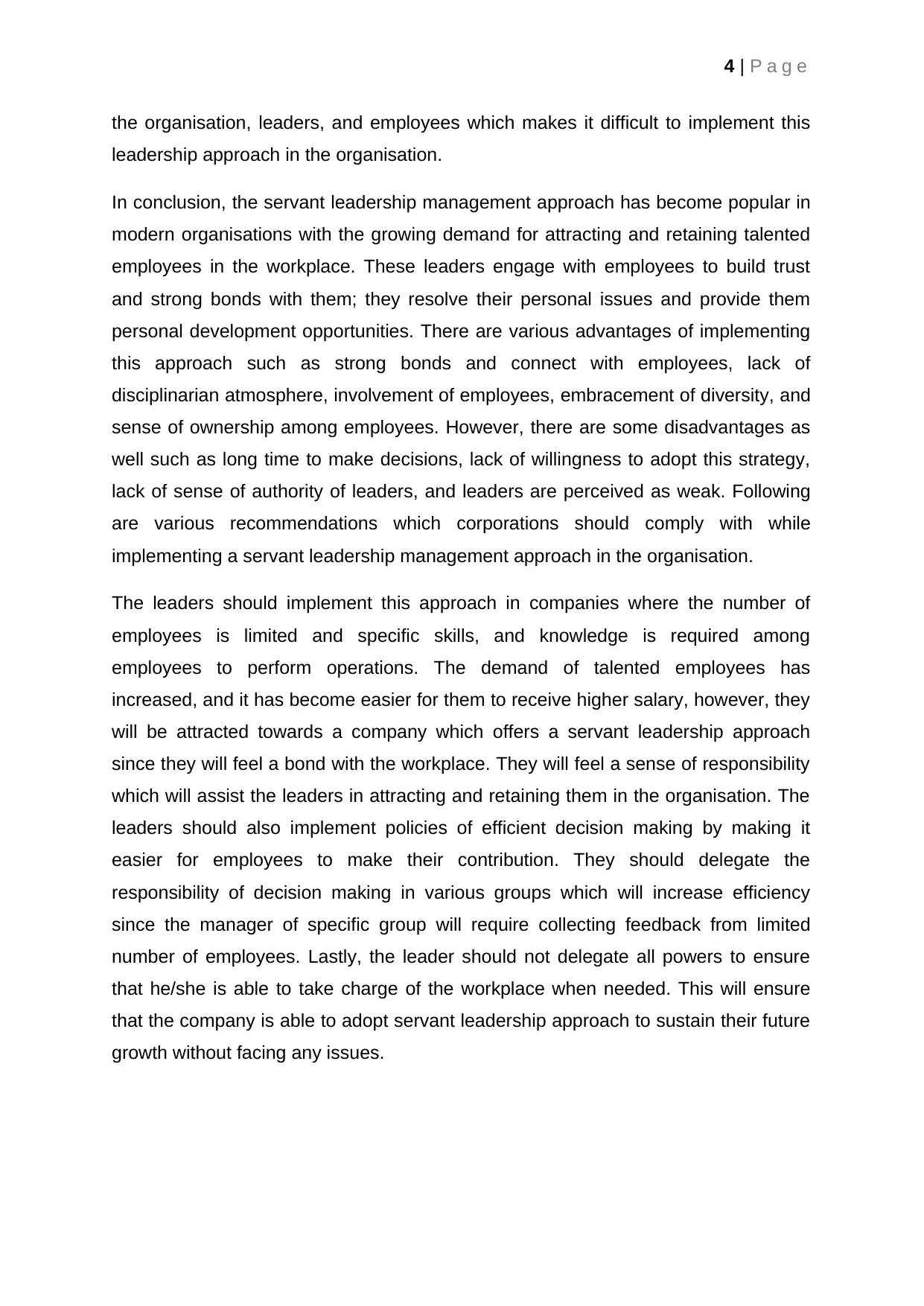
4 | P a g e
the organisation, leaders, and employees which makes it difficult to implement this
leadership approach in the organisation.
In conclusion, the servant leadership management approach has become popular in
modern organisations with the growing demand for attracting and retaining talented
employees in the workplace. These leaders engage with employees to build trust
and strong bonds with them; they resolve their personal issues and provide them
personal development opportunities. There are various advantages of implementing
this approach such as strong bonds and connect with employees, lack of
disciplinarian atmosphere, involvement of employees, embracement of diversity, and
sense of ownership among employees. However, there are some disadvantages as
well such as long time to make decisions, lack of willingness to adopt this strategy,
lack of sense of authority of leaders, and leaders are perceived as weak. Following
are various recommendations which corporations should comply with while
implementing a servant leadership management approach in the organisation.
The leaders should implement this approach in companies where the number of
employees is limited and specific skills, and knowledge is required among
employees to perform operations. The demand of talented employees has
increased, and it has become easier for them to receive higher salary, however, they
will be attracted towards a company which offers a servant leadership approach
since they will feel a bond with the workplace. They will feel a sense of responsibility
which will assist the leaders in attracting and retaining them in the organisation. The
leaders should also implement policies of efficient decision making by making it
easier for employees to make their contribution. They should delegate the
responsibility of decision making in various groups which will increase efficiency
since the manager of specific group will require collecting feedback from limited
number of employees. Lastly, the leader should not delegate all powers to ensure
that he/she is able to take charge of the workplace when needed. This will ensure
that the company is able to adopt servant leadership approach to sustain their future
growth without facing any issues.
the organisation, leaders, and employees which makes it difficult to implement this
leadership approach in the organisation.
In conclusion, the servant leadership management approach has become popular in
modern organisations with the growing demand for attracting and retaining talented
employees in the workplace. These leaders engage with employees to build trust
and strong bonds with them; they resolve their personal issues and provide them
personal development opportunities. There are various advantages of implementing
this approach such as strong bonds and connect with employees, lack of
disciplinarian atmosphere, involvement of employees, embracement of diversity, and
sense of ownership among employees. However, there are some disadvantages as
well such as long time to make decisions, lack of willingness to adopt this strategy,
lack of sense of authority of leaders, and leaders are perceived as weak. Following
are various recommendations which corporations should comply with while
implementing a servant leadership management approach in the organisation.
The leaders should implement this approach in companies where the number of
employees is limited and specific skills, and knowledge is required among
employees to perform operations. The demand of talented employees has
increased, and it has become easier for them to receive higher salary, however, they
will be attracted towards a company which offers a servant leadership approach
since they will feel a bond with the workplace. They will feel a sense of responsibility
which will assist the leaders in attracting and retaining them in the organisation. The
leaders should also implement policies of efficient decision making by making it
easier for employees to make their contribution. They should delegate the
responsibility of decision making in various groups which will increase efficiency
since the manager of specific group will require collecting feedback from limited
number of employees. Lastly, the leader should not delegate all powers to ensure
that he/she is able to take charge of the workplace when needed. This will ensure
that the company is able to adopt servant leadership approach to sustain their future
growth without facing any issues.
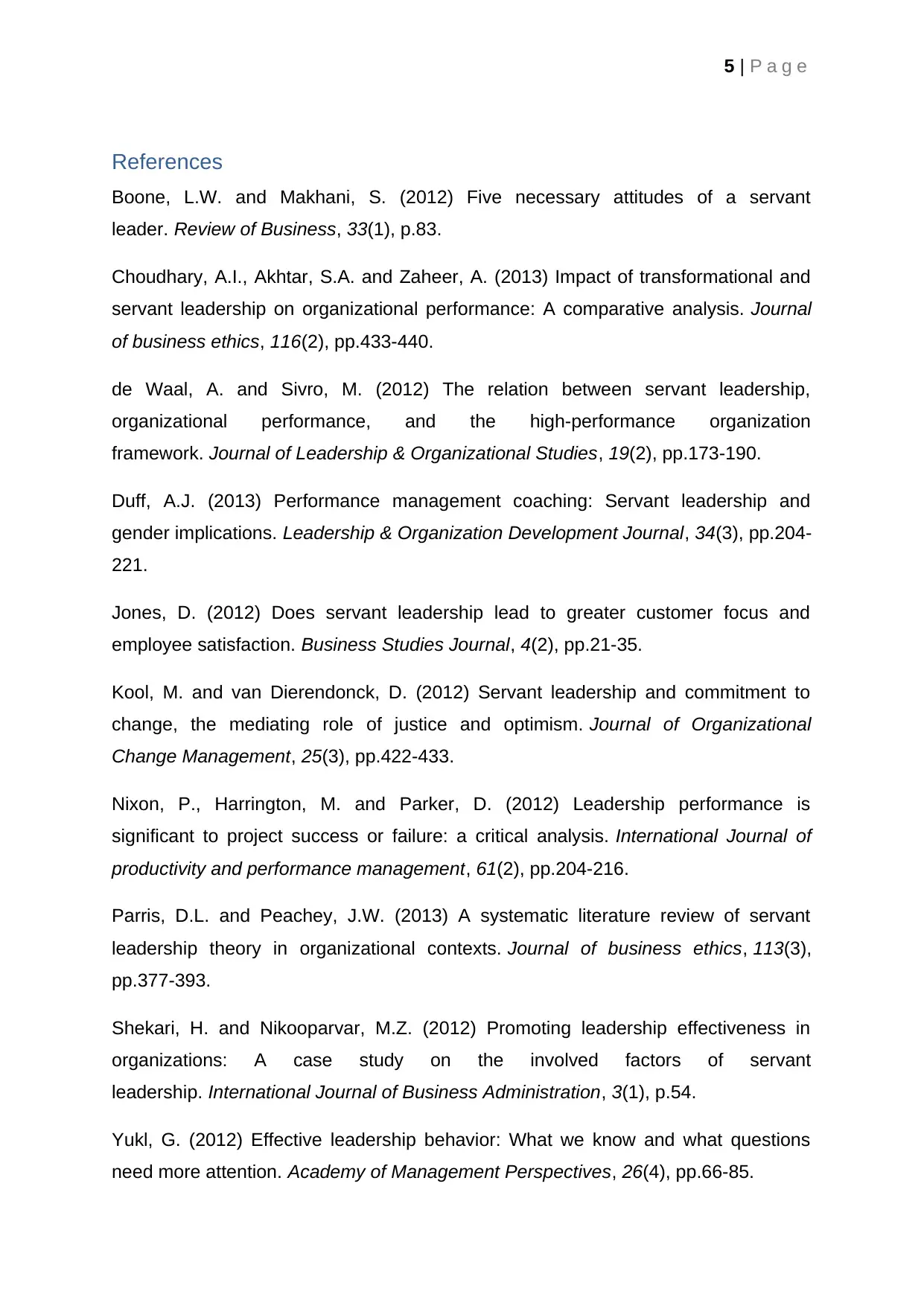
5 | P a g e
References
Boone, L.W. and Makhani, S. (2012) Five necessary attitudes of a servant
leader. Review of Business, 33(1), p.83.
Choudhary, A.I., Akhtar, S.A. and Zaheer, A. (2013) Impact of transformational and
servant leadership on organizational performance: A comparative analysis. Journal
of business ethics, 116(2), pp.433-440.
de Waal, A. and Sivro, M. (2012) The relation between servant leadership,
organizational performance, and the high-performance organization
framework. Journal of Leadership & Organizational Studies, 19(2), pp.173-190.
Duff, A.J. (2013) Performance management coaching: Servant leadership and
gender implications. Leadership & Organization Development Journal, 34(3), pp.204-
221.
Jones, D. (2012) Does servant leadership lead to greater customer focus and
employee satisfaction. Business Studies Journal, 4(2), pp.21-35.
Kool, M. and van Dierendonck, D. (2012) Servant leadership and commitment to
change, the mediating role of justice and optimism. Journal of Organizational
Change Management, 25(3), pp.422-433.
Nixon, P., Harrington, M. and Parker, D. (2012) Leadership performance is
significant to project success or failure: a critical analysis. International Journal of
productivity and performance management, 61(2), pp.204-216.
Parris, D.L. and Peachey, J.W. (2013) A systematic literature review of servant
leadership theory in organizational contexts. Journal of business ethics, 113(3),
pp.377-393.
Shekari, H. and Nikooparvar, M.Z. (2012) Promoting leadership effectiveness in
organizations: A case study on the involved factors of servant
leadership. International Journal of Business Administration, 3(1), p.54.
Yukl, G. (2012) Effective leadership behavior: What we know and what questions
need more attention. Academy of Management Perspectives, 26(4), pp.66-85.
References
Boone, L.W. and Makhani, S. (2012) Five necessary attitudes of a servant
leader. Review of Business, 33(1), p.83.
Choudhary, A.I., Akhtar, S.A. and Zaheer, A. (2013) Impact of transformational and
servant leadership on organizational performance: A comparative analysis. Journal
of business ethics, 116(2), pp.433-440.
de Waal, A. and Sivro, M. (2012) The relation between servant leadership,
organizational performance, and the high-performance organization
framework. Journal of Leadership & Organizational Studies, 19(2), pp.173-190.
Duff, A.J. (2013) Performance management coaching: Servant leadership and
gender implications. Leadership & Organization Development Journal, 34(3), pp.204-
221.
Jones, D. (2012) Does servant leadership lead to greater customer focus and
employee satisfaction. Business Studies Journal, 4(2), pp.21-35.
Kool, M. and van Dierendonck, D. (2012) Servant leadership and commitment to
change, the mediating role of justice and optimism. Journal of Organizational
Change Management, 25(3), pp.422-433.
Nixon, P., Harrington, M. and Parker, D. (2012) Leadership performance is
significant to project success or failure: a critical analysis. International Journal of
productivity and performance management, 61(2), pp.204-216.
Parris, D.L. and Peachey, J.W. (2013) A systematic literature review of servant
leadership theory in organizational contexts. Journal of business ethics, 113(3),
pp.377-393.
Shekari, H. and Nikooparvar, M.Z. (2012) Promoting leadership effectiveness in
organizations: A case study on the involved factors of servant
leadership. International Journal of Business Administration, 3(1), p.54.
Yukl, G. (2012) Effective leadership behavior: What we know and what questions
need more attention. Academy of Management Perspectives, 26(4), pp.66-85.

6 | P a g e
Zhang, Y., Lin, T.B. and Fong Foo, S. (2012) Servant leadership: A preferred style of
school leadership in Singapore. Chinese Management Studies, 6(2), pp.369-383.
Zhang, Y., Lin, T.B. and Fong Foo, S. (2012) Servant leadership: A preferred style of
school leadership in Singapore. Chinese Management Studies, 6(2), pp.369-383.
1 out of 7
Related Documents
Your All-in-One AI-Powered Toolkit for Academic Success.
+13062052269
info@desklib.com
Available 24*7 on WhatsApp / Email
![[object Object]](/_next/static/media/star-bottom.7253800d.svg)
Unlock your academic potential
© 2024 | Zucol Services PVT LTD | All rights reserved.





